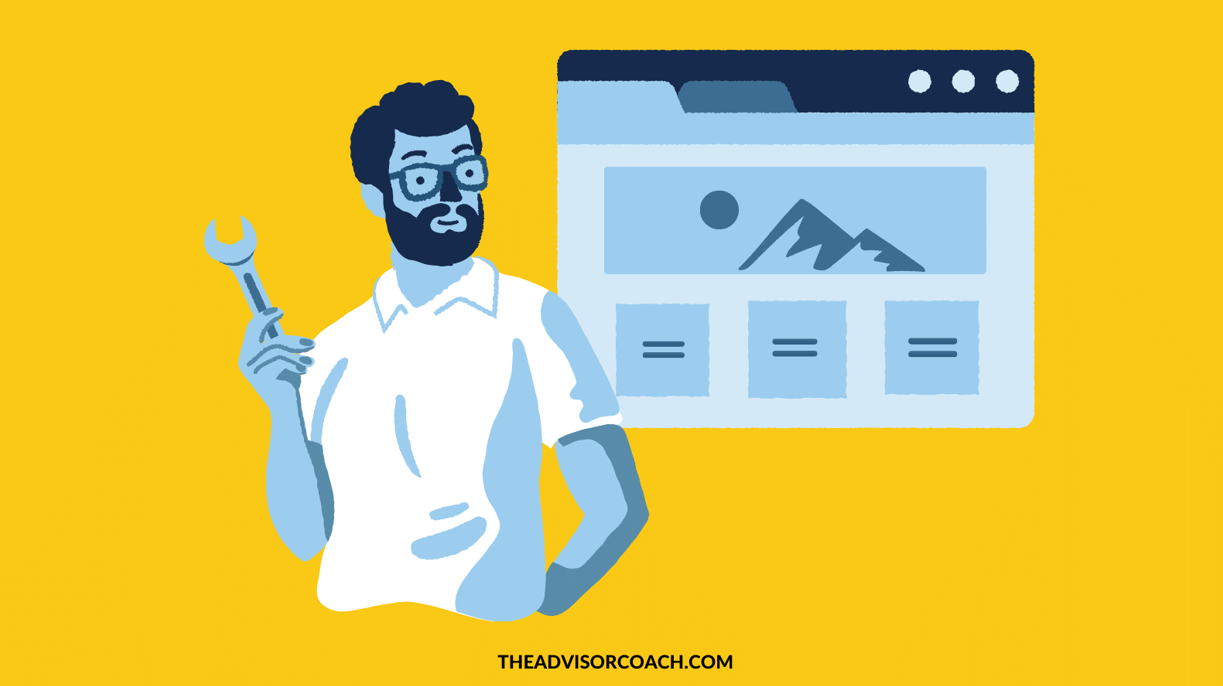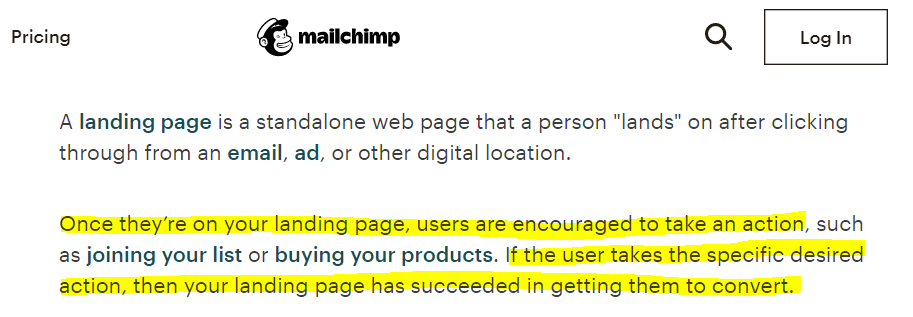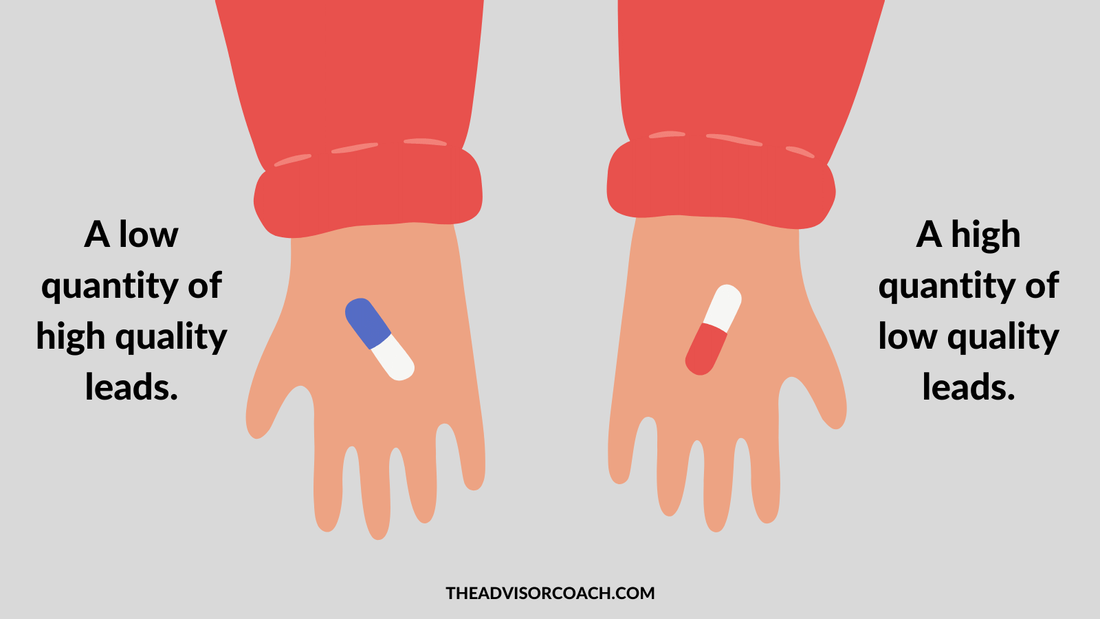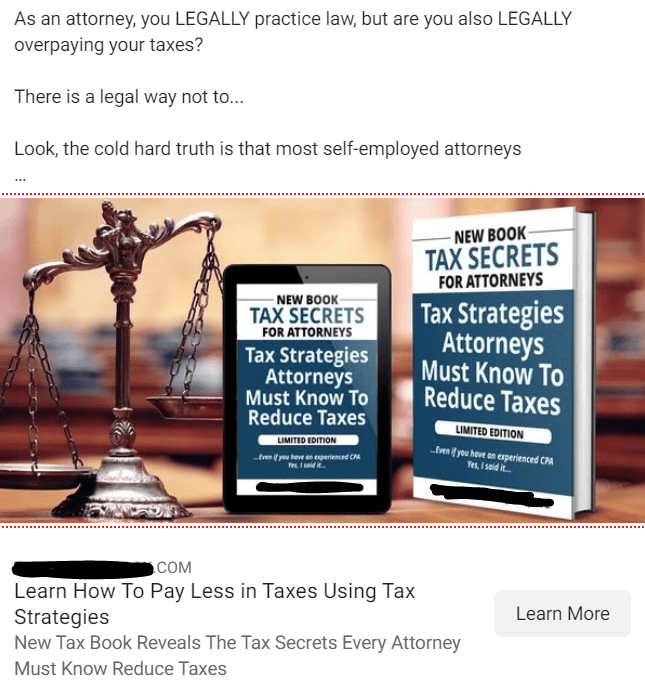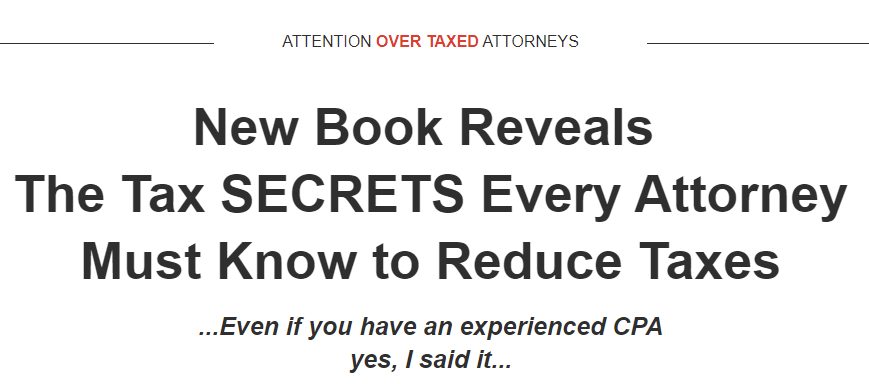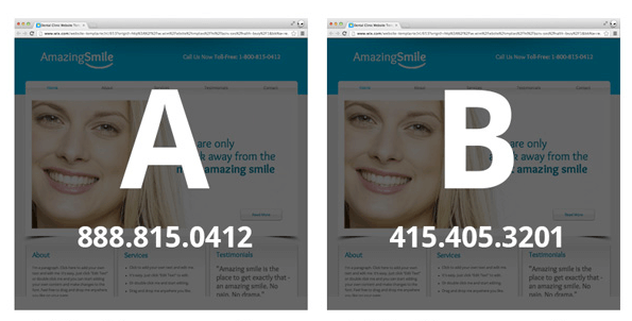5 Elements of High-Converting Landing Pages For Financial Advisors (With Examples)If you’re a financial advisor, this can strap a rocket ship to your business…
It’s something that, when done correctly, can generate more leads than you know how to handle… And it can save you time because it generates qualified leads instead of anyone who can fog a mirror. I’m talking about a landing page. A landing page is a page designed to get someone to take a specific action. If you listen to the Financial Advisor Marketing podcast, you’ve heard me use the words “landing page” and “opt-form” interchangeably when describing my email marketing system. However, a landing page can be much more than an email opt-in form. It can be:
And more. Because a landing page is designed to do one thing: convert visitors into leads. It does this by capturing information. That’s why, in the financial advice world, even the calendar page is *technically* a landing page because it captures information and turns visitors into leads. Here’s one definition of "landing page" from Mailchimp… My Landing Page Philosophy...My belief is that landing pages should strike a fine balance between the quantity and quality of leads generated.
It's possible to generate far more leads by using other people's advice. I don’t dispute that. You can open your doors to everyone, make big promises, and spend tons of resources to generate a higher quantity of leads. Likewise, it’s also possible to generate higher-quality leads by doing something other than what's described in this article. For example, you could have a long survey with a multi-step funnel. You could make people jump through hoops to get to you, although very few would make it to the end. When it comes to lead generation, you are constantly fighting a battle between high quantity/low quality and low quantity/high quality. I’ve discovered that, by incorporating these elements, you can have a healthy mix of both. 😄 It's true, adopting strategies from elsewhere or following conventional wisdom can skyrocket your lead count. There’s no denying that. Opening your doors wide, crafting grand promises, and channeling a significant portion of your resources can indeed fill your pipeline.
But then, you’re faced with a new challenge: sifting through a mountain of leads, many of which may not align with your ideal client profile. This is not just time-consuming but can dilute the effectiveness of your services. Conversely, there's a path less traveled that veers away from the standard playbook described in many marketing guides. Imagine implementing a lengthy, detailed survey coupled with a multi-step funnel. It's a strategy designed to filter out the less serious prospects, ensuring that only the most committed individuals reach you. The downside? The sheer rigor and length of the process might deter many, potentially even those who could have been great fits had they not been overwhelmed by the hurdles. This constant tug-of-war between attracting a large volume of leads and ensuring those leads are of high quality is the crux of lead generation. It's an ongoing battle between wanting more and wanting better. Too many leads can overwhelm your systems, diluting the personal touch that might be your unique selling proposition. On the other hand, too few, albeit high-quality leads, might not be enough to sustain and grow your business. But here’s the kicker: it’s not an either/or situation. Through strategic planning and a nuanced understanding of your target audience, it's possible to design landing pages and marketing funnels that serve dual purposes. They can filter out the least suitable prospects while still attracting a volume of leads sufficient to grow your business. Incorporating elements such as targeted questions that qualify leads, thoughtfully designed interactive elements that engage the right prospects, and content that speaks directly to the needs and challenges of your ideal clients can create this balance. By doing so, you’re not just casting a wide net but ensuring that the leads you do capture are more likely to convert into clients who value and need your services. This approach requires patience, testing, and a willingness to learn and adapt. It's about refining your methods based on real data and feedback, not just industry norms. By cultivating this balanced approach, you can build a landing page strategy that brings in leads that are both numerous and well-suited to your business, leading to more efficient conversions and a healthier, more sustainable growth trajectory. Now, let's dig into the elements that make landing pages successful... Element #1: Your Headline.I’m going to give you some lessons from David Ogilvy, who is one of the greatest advertisers of all time. He’s been responsible for some killer headlines, and here’s what he had to say…
Your role is to sell, don’t let anything distract you from the sole purpose of advertising. - David Ogilvy Your headline’s goal isn’t to be clever or witty. It’s also not to prove how creative you are. In one of his books, Ogilvy wrote about how he hated when his employees referred to themselves as “creative.”
People don't care about your creativity. They only care about what’s in it for them. So, I want to give you one of my favorite headline secrets of all time. Are you ready? Here it is… 💡 Clearly explain what people are going to get when they go through your landing page. That’s it. I know that sounds simple, but it works. Financial advisors typically don’t set as many appointments as they otherwise could because they don’t clearly explain what people get by having an appointment. Financial advisors typically don’t get as many email subscribers as they otherwise could because they don’t clearly explain what people get by subscribing. Here’s another example… this is a solid ad an accountant is running to get more attorney clients… First, I want you to notice the title of the lead magnet: “Tax Strategies Attorneys Must Know To Reduce Taxes."
If you’re an attorney, that title should catch your eye. It’s one of the reasons why having a niche is one of the best things you can do to get more clients. At the time of this writing, this ad has been running for a whopping ELEVEN MONTHS! It’s crushing it because it’s a solid offer being delivered to a niche audience. Not because of some Facebook targeting secret or algorithm “hack” touted by someone to sell you a Facebook ads system. When you click the ad, you’re taken to a page with this headline… This headline works because it succinctly defines the offer. It is:
If you include those things in your headlines, they will become more effective. However, this landing page takes it a step further by adding this gem: “Even if you have an experienced CPA.” This is an integral part of why the headline is such a winner because it addresses an objection many attorneys have. They may view this ad for tax planning services and think, “I already have a CPA, so it’s not for me.” With this one sentence, the objection is obliterated, and attorneys are more likely to convert. What are some ways you can address objections in your headlines? Let’s brainstorm. You can say things like:
David Ogilvy also said: On the average, five times as many people read the headline as the body copy. When you have written your headline, you have spent eighty cents out of your dollar. - David Ogilvy This means you should spend most of your time crafting your headline. Because most people will read your headline and make a snap decision about if they want to move forward. The more effective your headline is, the more people will move forward.
Here’s some more advice that can help you design incredible headlines… 💡 Write twenty-five headlines and pick your favorite five. This is based on the 80/20 rule. If you write twenty-five headlines, five of them will be the top 20% that you like more than the other 80%. Then, take your top five headlines and show them to people in your target market. NOT your family members… NOT your friends… And NOT other financial advisors. Have people IN YOUR NICHE tell you which headline they like best. That one headline is the top 20% of your top five, which means it’s almost certainly a winner. Element #2: A Strong Reason Why.Another master copywriter, John Carlton, offered an intriguing analogy to his students...
Picture your reader as a somnambulant sloth lounging on a couch. This isn’t just any lazy creature; we’re talking about a sloth so lethargic that mustering the energy to head to the bathroom during a commercial break is a monumental task, let alone taking action on your offer. To move this metaphorical sloth — to truly get them to convert — you need a compelling, irresistible reason. So, let’s dive into our example, “Tax Strategies Attorneys Must Know To Reduce Taxes.” Why, exactly, should attorneys leap at this offer? The immediate, surface-level answer is that it can save them money. But don’t stop there. Ask yourself: Why is saving money important to them? The deeper reasons might vary: they might want to reinvest the savings into their practice, afford luxury vacations, or simply enjoy more quality time with their families without financial stress hanging over them. Or, perhaps, they want the extra cash to indulge in personal pleasures, like a night out enjoying Mango Habanero wings at Buffalo Wild Wings. There's no room for judgment here; desires are diverse and personal. 😆 However, to truly sharpen your message's urgency, you need to nudge them further.Why should they act right now? Is there an expiration date on your offer? Are you providing special bonuses for a limited time only? Maybe there are only a handful of spots available for personal consultations or in your webinar audience. Speaking of webinars, they represent a golden opportunity for financial advisors, precisely because they come with built-in urgency. Webinars aren't evergreen; they're scheduled events. By promoting your session as a one-time event — say, “Join our exclusive webinar this Wednesday at 4:00 p.m.” — you create a natural urgency. People have a clear deadline; if they miss out, they lose the opportunity. This time sensitivity can be the push that moves the proverbial sloth from the couch to action. Every touchpoint, from your headlines to your call-to-action, needs to tap into the inherent motivations of your audience. It should resonate with their desires, alleviate their fears, and answer their most pressing questions. Remember, you're not just selling a service or product; you're offering a key to a more desirable outcome in their personal or professional lives. By articulating the tangible benefits they stand to gain and coupling those with a sense of urgency, you can turn even the most indifferent reader into an engaged, motivated lead ready to act. Element #3: Social Proof.⚠️ This may or may not work for you, so use it with caution.
Social proof was coined by Robert Cialdini in his 1984 book, Influence, and it’s basically when people copy the actions of others. As humans, we love to see what everyone else is doing. For example, people tend to feel more comfortable buying a product that has one hundred reviews instead of four. It’s also why celebrity endorsements work so well. As always, check with your compliance department before doing anything I write or talk about, but here are some ways to integrate social proof into your landing pages:
A note about that last bullet point… RingDNA split-tested a toll-free number vs. a local area code, as you can see below… Variant B with the 415 local area code lifted conversions by 40%.
Now, I’ll shoot straight with you: while I’ve seen social proof increase conversions, I’ve also seen it decrease conversions. For example, DIYthemes ran a test between two variants to see whether including the number of email subscribers led to more subscribers… The variant without the number (“14,752 others”) got 38% more conversions. 🤯
In my case, too much social proof also tends to decrease my conversions. For instance, sometimes I will receive emails from financial advisors asking if they can talk to my Inner Circle members before subscribing. (I’ve never understood this. It’s only $99 per month. If you need a background check and three references before parting ways with $99 per month, then you need the money. Don’t ever spend it. Clutch it tightly. Harder.) When I get this question, I like to respond with: “No, but if you subscribe, I would like to use you as a reference for people who ask in the future. Will you be a reference for me?” They either ignore me or say no. Do these people really believe that successful financial advisors are waiting by the phones all day long to help ease their insecurities? Get real. I also used to have testimonials on my opt-in pages. Sadly, the financial advisors asked me to take their testimonials down because they were getting hounded by people asking for reviews. Keep in mind this is for a FREE opt-in delivered by email where people can unsubscribe at any time. People STILL wanted handholding. My landing pages got tens of thousands of views, so even 0.1% of those people reaching out to the financial advisors added up to dozens of people emailing, calling, and messaging the people who left testimonials. Where was I going with this? Oh yeah, your mileage may vary with social proof. Element #4: Ease of Use.Once visitors land on your page, the journey to obtaining what you’re offering should be frictionless and intuitive.
For instance, if your landing page is dedicated to email signups, the process should be streamlined to encourage users to quickly and easily provide their email addresses. Consider the design and user experience: Is the sign-up form visible without scrolling (above the fold)? Is the form simple, asking only for essential information like their email address? Remember, each additional field can significantly reduce the likelihood of someone completing the form. Use clear, compelling language that communicates what visitors will receive in exchange for their email addresses, such as a free guide, newsletter, or consultation. If your landing page is focused on setting appointments, similarly, the path to booking should be devoid of any complexities. If a visitor has decided they want to meet with you, any confusion about how to schedule this meeting could deter them. Make sure the booking tool is integrated smoothly into the page, and instructions for setting an appointment are idiot-proof. For example, you could include a brief line such as, “Select the date and time that works best for you from the calendar below.” Ensure that any forms required to set the appointment are as concise as possible and that the steps they need to follow are laid out clearly. The overarching principle here is clarity. Don’t assume visitors know what to do; guide them through the process. Provide clear, step-by-step instructions for what they need to do. Think of it as if you’re guiding a five-year-old through the process: use simple language, remove unnecessary jargon, and ensure that each step is easy to complete. But it’s not just about making things simple. It’s also about making visitors feel comfortable and reassured throughout the process. If they're signing up for an email list, reassure them that their information is secure and that they can unsubscribe at any time. If they're booking an appointment, confirm the next steps after they’ve chosen a time slot — will they receive a confirmation email? Do they need to prepare anything for the meeting? Lastly, always test your landing page from the perspective of a new visitor. Navigate the page as if you're seeing it for the first time and adjust any steps or instructions that could potentially be confusing. The easier and more reassuring you make the process, the higher your conversion rates will be. Remember, the goal is to eliminate every possible barrier between your visitor and the action you want them to take. ALSO READ: I Analyzed The Websites of Barron's Top 100 Independent Financial Advisors Element #5: What Happens After...That’s right, the fifth element isn’t even on your landing page. It’s everything that happens after someone converts.
Let me make myself clear: if someone fills out a form on your website and all that happens is a generic message pops up saying, “Thanks for your message” or “Someone will be in touch with you soon,” then you are missing a massive opportunity. The best thing you can do once someone goes through your landing page is to send that person to a custom thank-you page based on whatever it is he or she did. When people book an appointment with you, redirect them to a thank-you page talking about your appointment process, what a good decision they’ve made, and so on. Reinforce what they’ve done. Congratulate them on their good behavior. When people opt in to your email list, redirect them to a thank-you page discussing whatever it is you’re delivering to their inbox. Thank them for subscribing and tell them what to expect in the future. If you email once per week, make that clear. Tell them to whitelist your email address so they receive your emails. But whatever you do — for the love of all that is good and holy — don’t just say “Thanks for subscribing” and leave them hanging. In my experience, the best way to immediately increase landing page conversions for financial advisors is to have a solid email follow-up sequence. This isn’t surprising because it’s rooted in real sales data. Another marketer named Robert Clay conducted some research and found that only 2% of sales occur after the first meeting. The other 98% will buy only once a certain level of trust has been established. And guess what builds that trust? Your email sequence. Clay also found that 80% of sales require at least five follow-up attempts. Knowing this, it’s easy to see how an email sequence of at least five emails can dramatically and permanently increase your conversions. I’m going to stop there because I don’t want this to turn into an article about email marketing, but if you want to learn more about how email is setting appointments for financial advisors, I encourage you to read this: 4 Things I’ve Learned From Sending 3.2 Million Financial Advisor Emails About The Author...
Hey, I'm James Pollard. I'm the guy behind this website.
I've dedicated my career to empowering financial advisors to unlock their full potential. With a passion for marketing and a knack for cutting through the noise, I provide actionable strategies and insights that help financial advisors build better businesses. I'm also the host of the popular Financial Advisor Marketing podcast. Beyond the mic, I'm constantly sharing my expertise through The James Pollard Inner Circle™ newsletter, which has grown to become one of the most successful communities in the financial advice space. Thanks for stopping by and diving into my world. If you'd like to connect with me on LinkedIn, here is where you can find me. |
